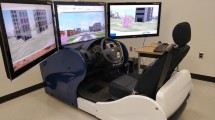Abstract
Various road occupation works pose potential risks of traffic accidents because they cause traffic bottleneck and congestion, which lead to unstable driving patterns such as quick deceleration and lane changes of vehicles. Even though guidance signs are installed and managed in work zones for preventing traffic accidents, the differences of installation criteria set by the Korea Expressway Corporation (KEC) and the Ministry of Land, Infrastructure and Transport (MOLIT) may increase the confusion of drivers. Therefore, this study set scenarios that take into consideration the colors and shapes of the work zone guidance signs used in driving tests through a virtual driving simulator and a survey on the preferences of drivers. According to the survey on the preference of drivers, 73% of the respondents analyzed prefer guidance signs in fluorescent orange color. In terms of driving patterns, the criteria of the KEC were found to induce smooth deceleration in expressway work zones than those of the MOLIT. In terms of driver concentration, the guidance signs conforming to the criteria of the KEC led to approximately 1.15 times higher concentration than those conforming to the MOLIT, which means that the former induce cautious driving in expressway work zones. The result of this study may be utilized as meaningful data for preventing traffic accidents by improving the traffic safety of road work zones on expressways and general roads, as well as by improving the traffic flow efficiency.
Similar content being viewed by others
References
Daniel J, Dixon K, Jared D (2000) Analysis of fatal crashes in Georgia work zones. Transportation Research Record (1715):18–23, DOI: https://doi.org/10.3141/1715-03
Hawkins HG, Carlson PJ, Elmquist M (2000) Evaluation of fluorescent orange signs. Texas Transportation Institute, The Texas A&M University System, College Station, TX, USA
Hirasawa M, Takemoto A, Asano M, Takada T (2007) Study on improving worker safety at roadway sites in Japan. Transportation Research Record 2015(TRB):41–54, DOI: https://doi.org/10.3141/2015-06
Hong JY, Kim KT, Lee SB (2011) Developing the accident injury severity on a field of construction work using ordered probit model. KOSOS 26(2):88–98, DOI: https://doi.org/10.14346/JKOSOS.2011.26.2.089
KEC (2013) Guideline of the traffic management for expressway work zone. Korea Expressway Corporation, Gimcheon, Korea
Ko SK, Choi KC, Lee SS, Yun IS (2012) A conspicuity effect study of fluorescent orange color traffic sings for work zone application. Journal of The Korean Society of Civil Engineers 32(5D):437–444, DOI: https://doi.org/10.12652/Ksce.2012.32.5D.437
Li Y, Bai Y (2012) Determining optimal deployment location of portable changeable message sign upstream of work zones. Transportation research board 91st annual meeting, January 22–26, Washington DC, USA
Meng Q, Weng J, Qu X (2010) A probabilistic quantitative risk assessment model for the long-term work zone crashes. Accident Analysis & Prevention 42(6):1866–1877
MOLIT (2010) Highway signs manufacturing and installation guideline. Ministry of Land, Infrastructure and Transport, Sejong, Korea
Park TH, Park JJ, Yoon P (2008) A study on traffic accident caracteristics of freeway work zones. ITS 7(1):127–136
Ullman BR, Ullman GL (2010) Evaluating innovative ideas in pedestrian signing for temporary traffic control. Transportation Research Record 2149(TRB):21–29, DOI: https://doi.org/10.3141/2149-03
Wang CY, Karen D, David J (2003) Evaluating speed reduction strategies for highway work zones. Transportation Research Record 1824(TRB): 44–53, DOI: https://doi.org/10.3141/1824-06
Acknowledgments
This research was supported by a grant (16CTAP-C098646-02) from Technology Advancement Research Program (TARP) funded by Ministry of Land, Infrastructure and Transport of Korean government.
Author information
Authors and Affiliations
Corresponding author
Rights and permissions
About this article
Cite this article
Park, J.J., Seo, I.K. & Lee, G.Y. Evaluation of the Expressway Work Zone Guidance Systems Using a Virtual Driving Simulator. KSCE J Civ Eng 25, 1446–1454 (2021). https://doi.org/10.1007/s12205-021-0868-1
Received:
Accepted:
Published:
Issue Date:
DOI: https://doi.org/10.1007/s12205-021-0868-1




